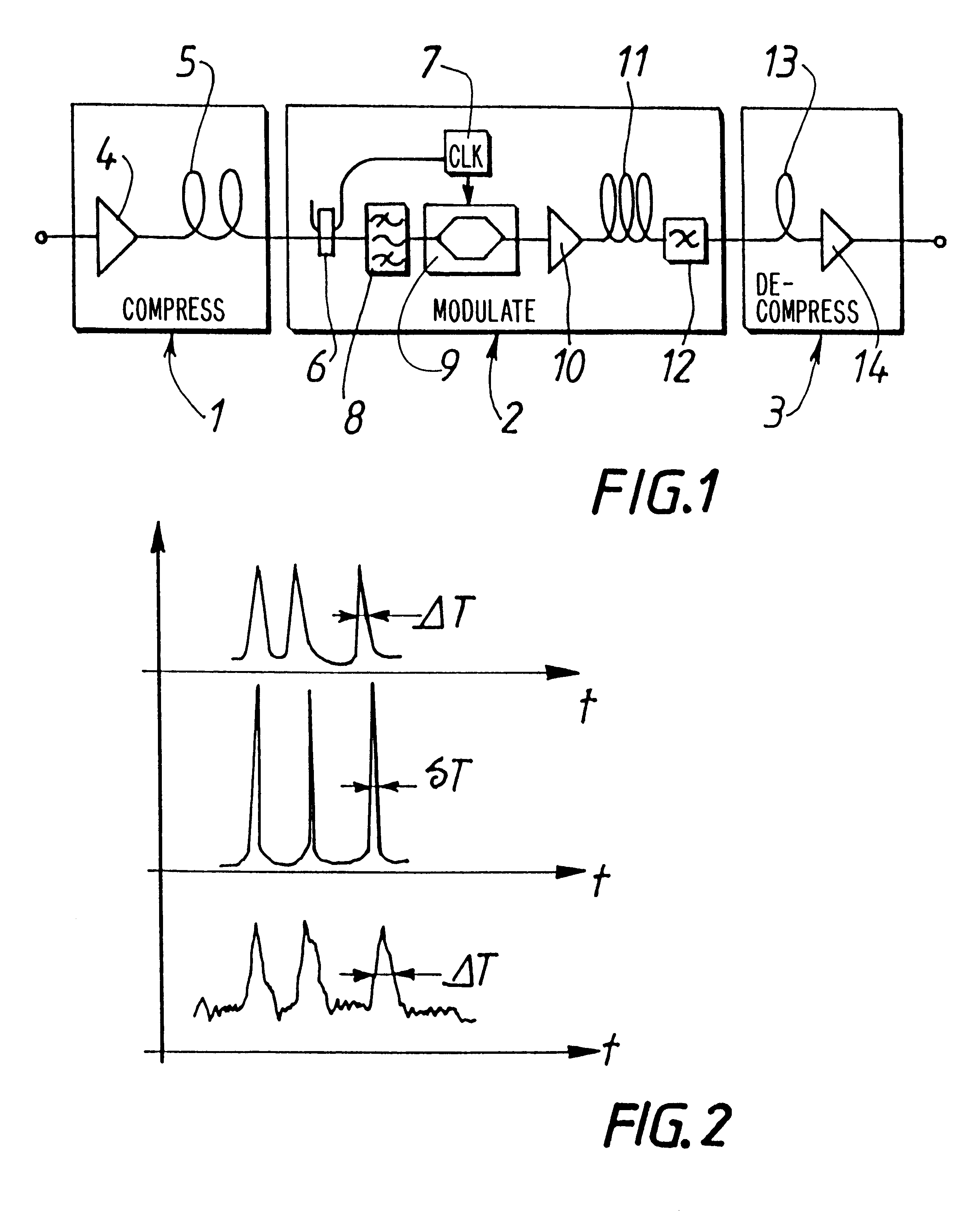Optical regeneration for optical-fiber transmission systems for non-soliton signals
- Summary
- Abstract
- Description
- Claims
- Application Information
AI Technical Summary
Benefits of technology
Problems solved by technology
Method used
Image
Examples
first embodiment
FIG. 1 is a diagram showing a regenerator of the invention. The FIG. 1 regenerator is designed to be used in an optical fiber transmission system for RZ signals, as in a commonly installed terrestrial system. The FIG. 1 regenerator comprises compression means 1 for compressing the RZ signals into soliton-type signals, modulation means 2 for performing synchronous optical modulation on the soliton-type signals, and decompression means 3 for decompressing the modulated soliton signals into non-soliton RZ signals.
The compression means 1 in the embodiment shown in FIG. 1 include a preamplifier 4 which receives the RZ optical signals to be regenerated. The outlet of the pre-amplifier 4 is connected to a compression fiber 5, e.g. a Kerr fiber having high dispersion. It is possible to vary the dispersion of the fiber as a function of distance so as to optimize the compression factor. The fiber delivers compressed signals which behave like soliton signals. It is possible to use some other c...
second embodiment
FIG. 3 is a diagram showing a regenerator of the invention. In this embodiment, the synchronous modulation is applied twice to the soliton-type signals, so as to reduce the amplitude noise. The amplitude noise is removed in part by the first synchronous modulation, because of the duty ratio of the modulation clock. The noise is dispersed during the propagation, and it is again removed in part by the second synchronous modulation, as explained in the above-mentioned passage from the article by H. Kubota.
Like the FIG. 1 regenerator, the regenerator shown in FIG. 3 comprises compression means 21, modulation means 22, and decompression means 23. The compression means 21 and the decompression means 23 are not described in any more detail. At their inlet, the modulation means include a three-port circulator 24 which receives the soliton-type signals to be modulated via a first port, and transmits them so that they are output via a second port. The signals to be modulated are delivered to ...
third embodiment
FIG. 4 is a diagram showing a regenerator of the invention that is suitable for multiplexed RZ signals. The FIG. 4 regenerator is suitable for the case when multiplexing is applied in the transmission system to the non-soliton RZ optical signals. It may be time division multiplexing (OTDM) or wavelength division multiplexing (WDM).
At its inlet, the regenerator shown in FIG. 4 includes demultiplexing means 35 for demultiplexing the multiplexed RZ optical signals, which demultiplexing means deliver the signals of the various channels at a plurality of outlets. It then includes a plurality of regenerators 36.sub.n to 36.sub.n, of the type described with reference to FIGS. 1 to 3, which regenerators apply synchronous modulation to the demultiplexed RZ signals. After the regenerators, the FIG. 4 circuit includes multiplexing means 37 for multiplexing the regenerated signals. It is clear to a person skilled in the art how the FIG. 4 regenerator operates. This regenerator makes it possible...
PUM
 Login to View More
Login to View More Abstract
Description
Claims
Application Information
 Login to View More
Login to View More - R&D
- Intellectual Property
- Life Sciences
- Materials
- Tech Scout
- Unparalleled Data Quality
- Higher Quality Content
- 60% Fewer Hallucinations
Browse by: Latest US Patents, China's latest patents, Technical Efficacy Thesaurus, Application Domain, Technology Topic, Popular Technical Reports.
© 2025 PatSnap. All rights reserved.Legal|Privacy policy|Modern Slavery Act Transparency Statement|Sitemap|About US| Contact US: help@patsnap.com



